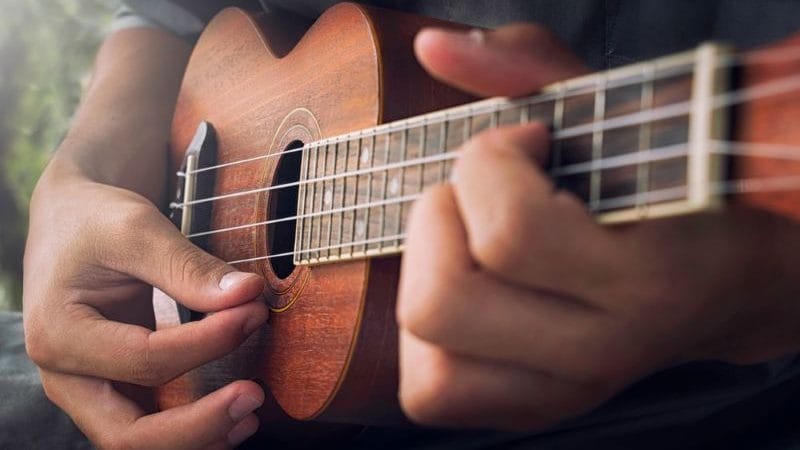Learn how to hold the ukulele through understanding the different parts of the instrument and finding the best fit for you.
Written by Shaylie M / Published July 12, 2024
Last updated: July 13, 2024

Learning to hold the ukulele is one of the foundational pieces to becoming comfortable with the instrument. In this article, we will firstly discuss the different parts of the ukulele. After we are familiar with all of the major parts of the ukulele, we will be ready to learn how to hold it properly.
We will also discuss how the size of the ukulele may be an important factor to finding the most comfortable fit for you.
Parts of the Ukulele
The major parts of the ukulele you will want to be familiar with are the body, neck, bridge, tuning pegs, and sound hole.
Some of these parts you may be able to intuitively identify with a quick glance, however, we will cover these to ensure you feel confident in your ukulele knowledge.

- The body has an hourglass shape and takes up the largest amount of space on the instrument. The top half of the body is usually slimmer than the bottom half.
- The sound hole is the circle in the center of the body that helps the instrument to create the resonant, warm sound that makes the ukulele so fun and rewarding to play.
- The neck is the longest part of the ukulele stretching from the body to the headstock
- The frets are the metal lines that go across the neck and guide players where to put their fingers when they are playing.
- The strings stretch vertically across the instrument and are assigned specific pitches.
- The nut is found at the top of the neck.
- The tuning pegs are found at the top of the instrument, which helps the player to adjust the pitch of the strings.
- The headstock is where the tuning pegs attach to the ukulele at the very top of the instrument.
How to Hold the Ukulele
Sitting Position
To begin learning how to hold the ukulele, it is recommended to begin sitting in a chair, on a stool, or a bench so your knees are bent at a 90 degree angle. Another option is to sit with legs criss crossed on the floor.
Choose whichever feels the most comfortable for you. You may want to experiment with both postures to find what feels best.
Holding the Instrument
When playing the ukulele, the right hand will be used for strumming and the left hand is used to create different chords. The following steps will guide you in how to hold the ukulele:
1 – Hold the ukulele so the back of the body (the side without strings) can rest against your body or very close to your body.
2 – Take the bottom edge of the body and rest it where your hip and waist meet on your right side. This will help you to hold the ukulele and press strings when you begin playing chords.
3 – Your left hand will be up at the top of the neck on the ukulele.
4 – Rest the thumb on the back of the neck up near the nut. By having your thumb on the back of the neck, this will help you to create tension on the strings as you begin to play the ukulele.
5 – Your right wrist will rest near the bottom of the body so your right hand is ready to strum near the top of the sound hole.


Different Sizes of Ukuleles
There are five different sizes of ukuleles. The soprano ukulele is the most popular size, however, it may not be the most comfortable size of ukulele to hold or play for everyone because it is the smallest ukulele.
A medium size ukulele could feel more natural for holding and playing. A tenor ukulele is five inches larger than the soprano ukulele and that will give more space for a player if the soprano feels too small. For reference, a chart below lists the types of ukuleles and their approximate size in inches or centimeters.

Ukulele Size Comparison Chart
| Ukulele | Size in Inches | Size in Centimeters |
| Soprano | 21 in | 53 cm |
| Concert | 23 in | 58 cm |
| Tenor | 26 in | 66 cm |
| Baritone | 29 in | 74 cm |
| Bass | 30 in | 76 cm |
I personally prefer the tenor ukulele compared to the soprano ukulele. I have medium-sized hands for a female and am around 5’5” tall, making me around average for a woman. When I hold and play the soprano ukulele, it is so petite it feels harder to hold on to and feel assured I have a good grip. Comparably, the tenor ukulele feels much more natural to hold, play, and strum because it has more surface to hold near my body.


If you’re not sure what size ukulele you should play, experiment and try different sizes to see what feels best for your body! You can go to a local music store and ask to look at, hold, and strum different sizes of ukuleles before buying one. Staff working may notice features or have helpful recommendations to lead you toward a great fit. When you find a size that feels best, you will feel confident practicing how to hold the ukulele and be onto the next step to playing!
Conclusion
While holding a ukulele may appear to be pretty straightforward, ensuring that you do so correctly from the very beginning can have a big impact on your playing. It’s important to note that you may have to adjust your position slightly if you move up or down a size. Ultimately though, the basics of how to hold a ukulele should be fairly consistent regardless.

Shaylie M
WriterShaylie has shared a love for music for as long as she can remember. Since completing her degree in Music Education, she has quickly found the ukulele to be her favorite instrument to teach her young students in her role as an elementary music teacher.




